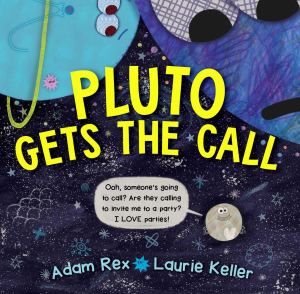Pluto loved being a planet but then receives the call that demotes him. He decides to head to the Sun to plead his case and on the way comments, mostly unfavourably, on the other planets as he passes them. The Sun consoles him with the fact that he now has a warm place in our hearts. With humour, we learn some facts about the solar system.
Adam Rex, Simon and Schuster, Beach Line Books, ©2019 978-1-5344-1453-2
Memorizing the Planets – In Order
Yes, there’s a mnemonic—My Very Enthusiastic Mother Just Served Us Noodles—but for me it’s as hard to remember the sentence as it is to remember the planets in order. I was once taught a story that works, because narrative is easiest to remember.
First, remember there are 4 inner smaller rocky planets, and 4 larger gas planets. Also, this names the planets from the sun out which means, for example, that if I say “Jupiter” you will always be able to say it is between Mars and Saturn.
Right next to the Sun, there was a very zippy planet called Mercury, named after the Messenger God because of its speed. Unfortunately, Mercury sneezed on the next planet over, which was the beautiful planet, Venus. Now mercury is poisonous so Venus scooped it up and threw it on the next planet, Earth. Earth didn’t want it either, and threw it onto Mars, the next planet and an angry red planet named after the god of war.
Mars was just winding up to throw it, when over the hill came a giant, that reached to the clouds, Jupiter. He was wearing a t-shirt with a huge red circle in the middle surrounded by the letters S.U.N. (Saturn, Uranus, Neptune). In the old days, he also had worn a ridiculous beanie cap on top of which was a tiny little model of the cartoon dog Pluto, but he doesn’t wear it any more.
Tales in Space
For general vocabulary, it’s a good idea to try out the Two Dozen Words You Need to Explore Space. Actually, I made that up, but they are still good words: satellite, orbit, rocket, space station, sputnik, comet, meteor, nebula, vacuum, astronomy, solar wind, big bang, Kuiper Belt, stardust, asteroid belt, International Space Station, telescope, cosmonaut/astronaut, heliosphere, black hole, galactic, magnetosphere, NASA, Canada Arm.
Once they have the words in their space suit, so to speak, ask them to write a story incorporating at least 10 of the words. It could be a space adventure such as Guardians of the Galaxy with a hero, an oddball sidekick, and a quest. It’s okay for them to create another adventure for characters they already know. The idea is to stretch their vocabulary into active use.
Ask them to highlight the words they use because there will be 2 marks: 1 for using the words, and 1 for the story, and you want your marking to be as easy as possible.
The Gods of the Greeks and Romans Are With Us Today
Give students a list of the products and events in our life that relate to the Gods of Greece and Rome. Ask each student to research one of them: what is the product and what does it do, what is the story behind the god it is named after, and why they feel that connection is appropriate. Prepare a quick PowerPoint or Keynote with pictures of the product or event. Students will turn in their paper, and also make an oral presentation. Two marks from one assignment and it’s fun too.
Here are some products: Nike shoes, Pandora jewelry, Versace designer uses the Medusa head, Ajax cleaner, Hermes fashion, Starbucks siren/ mermaid symbol, Trident gum, Goodyear tires with the flying sandal, FTD florists’ symbol of Mercury, Amazon delivers, Mars candy bar, Oracle database software, Ambrosia salad, Apollo Theatre in New York City, Delphi software, Vulcanized rubber, Centaur pharmaceuticals, Echo Digital Audio, Europa (website of the EU), Hyperion Records, Odyssey records, Pegasus travel, Poseidon Seafood, Prometheus books, Titans ()NFL team), Triton Tool and Die, Mercury Car, the Nissan Titan, the Volkswagen Phaeton, Venus Beauty supplies, Pegasus symbol of Mobil Oil. Honda Odyssey.
For more creative writing ideas, click Pluto Gets the Call to download.

 Bruce, the bear, is gathering eggs for his dinner recipe, but unfortunately they hatch. The ducklings immediately imprint on Bruce and follow him everywhere. After trying to get them to leave he gives up and raises them, even trying to teach them to migrate. When that fails, they end by vacationing in Miami every year.
Bruce, the bear, is gathering eggs for his dinner recipe, but unfortunately they hatch. The ducklings immediately imprint on Bruce and follow him everywhere. After trying to get them to leave he gives up and raises them, even trying to teach them to migrate. When that fails, they end by vacationing in Miami every year.
 In 1877, George Eastman started what was then the complicated hobby of photography. He decided to invent a camera—the Brownie—that would make it possible for everyone to take pictures and today, we can take pictures with our phones.
In 1877, George Eastman started what was then the complicated hobby of photography. He decided to invent a camera—the Brownie—that would make it possible for everyone to take pictures and today, we can take pictures with our phones.